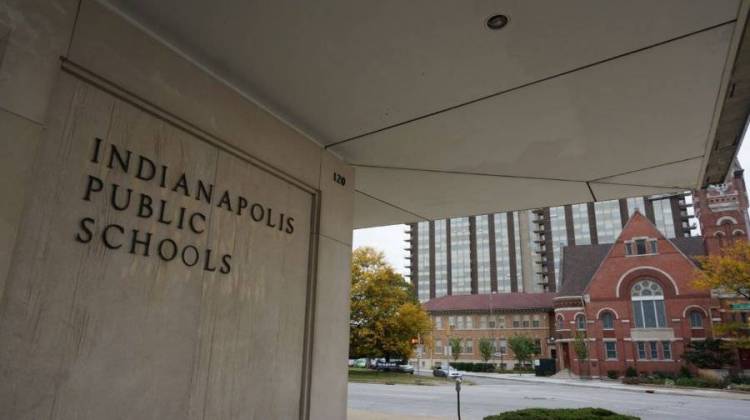
During the June board meeting, the district provided an update on their work to have more equitable schools, passed a resolution supporting the LGBTQIA+ community and approved nine new board goals.
(WFYI file photo)Although students and teachers are out of school for the summer, equity and inclusion is still a hot topic in Indianapolis Public Schools. During the June board meeting, the district provided an update on their work to have more equitable schools, passed a resolution supporting the LGBTQIA+ community and approved nine new board goals.
Update on IPS’ Equity Work
It’s been a year since the board passed a racial equity policy and Black Lives Matter resolution following social justice protests in Indianapolis and across the country. The board offered an update Thursday on where the plans stood. Pat Payne, director of the IPS racial equity office, said when the district talks about having racial equity as a core value, it’s about making sure all students and staff receive the resources they need to be successful.
“We are not talking about critical race theory,” Payne said. “We’re talking about building diverse, inclusive, equitable, anti-racict classrooms. You’re either a racist or you’re an anti-racist. There is no inbetween.”
Following approval of the resolution last year, the district began monthly racial equity case studies among school leaders and teams at each school who focus on equity concerns. IPS is also in the process of launching a parent equity group initiative, staff affinity groups and a conflict resolution pilot.
The affinity groups aim to provide a safe space for people who identify in the same way. The initiative already has 200 registered employees in roughly two weeks and will include at least 12 initial group options such as Indigenous/Native American, LGBTQ, Ability/Diverse, Women’s Network and Confronting White Privilege. The district said each affinity group will be responsible for creating a program or initiative with another affinity group, and present feedback to the district.
The focus on making staff feel more comfortable comes as the district struggles to attract diverse applicants for staff positions. A recent audit found the percentage of employee applicants of color declined.
Andrew Strope, IPS chief strategy and planning officer, said the “community accountability pilot” will be a conflict resolution framework facilitated by a small group of IPS “stakeholders.” Strope said it will allow people “who have experienced an injustice an opportunity to address and repair harm that they’ve experienced.”
“As we expand our efforts to become a more inclusive district, we should anticipate that conflicts might arise,” Strope said. “And we need to have something in place that is not necessarily punitive because this is a learning journey for all of us. We want to empower individuals in the community in order to address those conflicts within their own communities because they’re best positioned to do so.”
Payne, an educator of more than 50 years, who has long called out inequities in the community and the district, said she’s proud of the district’s work so far.
“I have never, in my experience in this school district, seen what I am seeing going on now to make sure that racial equity is not just something that we talk about, but something that is actually being put in place,” Payne said.
An overview of the district’s 2025 strategic plan is online. District leaders plan to provide a more detailed version in August. IPS also plans to host a racial equity community conversation in late July.
LGBTQIA+ Resolution
The IPS board of commissioners unanimously approved a resolution in support of the LGBTQIA+ community, which aligns with their equity work.
“All people, particularly all students, must be protected by schools from bullying and discrimination based on their gender identity and sexual orientation,” the resolution states. “No student should experience any form of harassment or any unfair treatment while in the care of Indianapolis Public School District.”
The complete resolution can be found on the IPS website.
Nine New Board Goals
Board commissioners also unanimously passed nine new board goals intended to improve student academics over the next four years.
The goals include increasing the graduation rate to 87 percent by 2025. Currently, the graduation rate is 75 percent. There’s also a focus on bridging the gap between English language arts and math performance scores for Black and Latinx students.
IPS Board of Commissioners President Evan Hawkins said goals should be aspirational for students.
“We’re laser focused on racial equity and eliminating achievement gaps,” Hawkins said. “This is absolutely a priority and we must recognize that the practice of predetermining academic outcomes by race must be disrupted.”
The following are the nine new board goals the district wants to improve by 2025, based on data from the 2018-2019 school year (excluding the IPS innovation schools and charter partners):
- Increase the percentage of students in grades 3-8 who meet or exceed grade-level standards in English Language Arts (ELA) from 22 percent to 50 percent, as measured by the ILEARN assessment.
- Increase the percentage of students in grades 3-8 who meet or exceed grade-level standards in Math from 21 percent to 50 percent, as measured by the ILEARN assessment.
- Increase the percentage of students who graduate within four years from 82.39 percent to 87 percent, as measured by IDOE graduation requirements.
- Increase the percentage of Black students in grades 3-8 who meet or exceed grade-level standards in ELA from 13.7 percent to 50 percent, as measured by the ILEARN assessment.
- Increase the percentage of Black students in grades 3-8 who meet or exceed grade-level standards in Math from 12.7 percent to 50 percent, as measured by the ILEARN assessment.
- Increase the percentage of Latinx students in grades 3-8 who meet or exceed grade-level standards in ELA from 19.9 percent to 50 percent, as measured by the ILEARN assessment.
- Increase the percentage of Latinx students in grades 3-8 who meet or exceed grade-level standards in Math from 19.5 percent to 50 percent, as measured by the ILEARN assessment.
- Increase IPS schools’ family engagement to 100 percent, as measured by school-based reports.
- Increase enrollment within the IPS portfolio of schools by 20 percent. The baseline enrollment is 31,171. A 20 percent increase means the district would have to enroll 6,234 students.
According to board documents, all leading indicators and the data reporting calendar will be refined and adopted in July.
Contact WFYI education reporter Elizabeth Gabriel at egabriel@wfyi.org. Follow on Twitter: @_elizabethgabs.
 DONATE
DONATE






 Support WFYI. We can't do it without you.
Support WFYI. We can't do it without you.